Apr 18, 2024
Apr 18, 2024
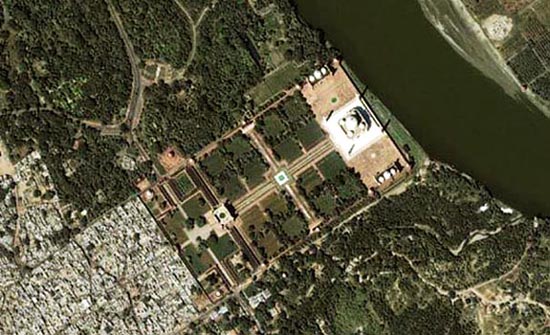
Satellite image of Taj and Agra courtesy of SpaceImaging.com
The Taj Mahal is widely acclaimed as the best example of Mughal tomb architecture, and is indeed famous all over the world as one of India’s most enduring architectural symbols. Begun in the fifth year of the reign of Shah Jahan as a monument to his dead wife Mumtaz Mahal, the Taj is located on the banks of the river Yamuna in Agra.
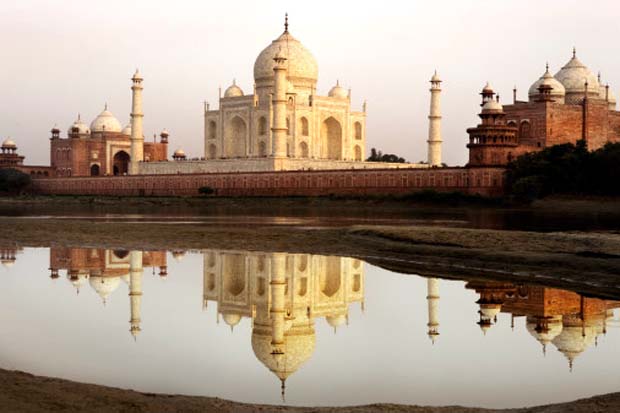
Image under license with Gettyimages.com
Much has been written about the Taj and its ethereal quality. What is clear from the mass of analyses available is that no consensus exists about the symbology that the composition is supposed to represent. Even scholarly writers are susceptible to hyperbole: “Yet, elusive in scale, it is ambiguous in form: the main arcades express the fusion of the five elements of the hasht behisht; the dome and chhattris express their distinction. And the materials – the water of canal and river – as much as the substance on the terrace – takes this incomparable work even further from the realm of rational analysis. In contrast to the red sandstone mosque and guesthouse flanking it, the mausoleum is built of marble of legendary beauty passing through a range of colors from peach to pearl according to the light of the sun, moon or stars.” *
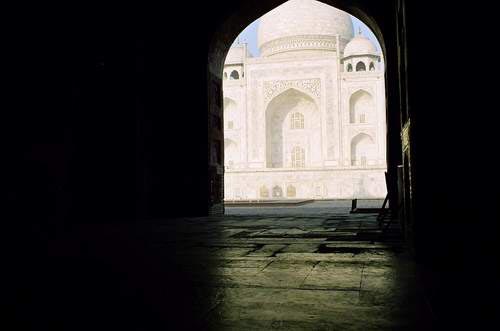 In plan the Taj composition offsets the chahar bagh preceding the tomb so the garden is no longer in the exact centre of the composition. Both axes of the garden have broad causeways with water channels flanked by cypress trees, and these meet in a raised water body. The north-south axis, however, leading from the main gate to the tomb, has fountains along the water channel to reinforce its centrality. The main axis then leads on to the superstructure, supported on an arcaded platform, is entirely faced with marble, as is the rest of the tomb. A significant improvement over Humayun’s tomb is that the platform is not high enough to mask the lower part of the superstructure and thus the entire building is visible from the entrance gate.
In plan the Taj composition offsets the chahar bagh preceding the tomb so the garden is no longer in the exact centre of the composition. Both axes of the garden have broad causeways with water channels flanked by cypress trees, and these meet in a raised water body. The north-south axis, however, leading from the main gate to the tomb, has fountains along the water channel to reinforce its centrality. The main axis then leads on to the superstructure, supported on an arcaded platform, is entirely faced with marble, as is the rest of the tomb. A significant improvement over Humayun’s tomb is that the platform is not high enough to mask the lower part of the superstructure and thus the entire building is visible from the entrance gate.
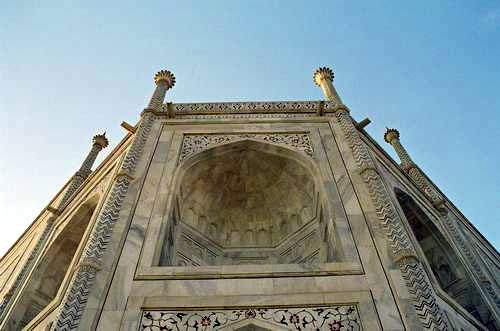
Taj Mahal - Detail of corner of Hasht Behisht courtesy Harneet Bhatia
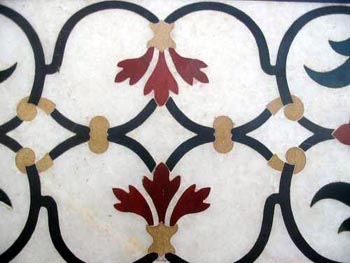 The hasht behisht – ‘eight paradises’ – is the name given to the eight chambers formed in a typical Islamic tomb type, four created by the crossing of the axes, and four by the diagonal chambers left over. In the Taj the hasht behisht is similar to the one in Humayun’s tomb, but with more emphasis on the axes. The tomb also has a double dome which consists of a lower inner shell and a much higher outer shell. This was done to keep the scale to a reasonable level in the interior. A rich dado of flowering plant motifs runs all around the building. Another remarkable feature of the tomb is of course the richly carved marble screens which ring the cenotaphs (raised marble platforms depicting burial places) of Shah Jahan and his queen.
The hasht behisht – ‘eight paradises’ – is the name given to the eight chambers formed in a typical Islamic tomb type, four created by the crossing of the axes, and four by the diagonal chambers left over. In the Taj the hasht behisht is similar to the one in Humayun’s tomb, but with more emphasis on the axes. The tomb also has a double dome which consists of a lower inner shell and a much higher outer shell. This was done to keep the scale to a reasonable level in the interior. A rich dado of flowering plant motifs runs all around the building. Another remarkable feature of the tomb is of course the richly carved marble screens which ring the cenotaphs (raised marble platforms depicting burial places) of Shah Jahan and his queen.
Two later tombs were clearly inspired by the Taj Mahal. The first is the tomb of Rabi Daurani, wife of Aurangzeb, built at Aurangabad less than thirty years later and the tomb of Safdar Jang, Nawab of Oudh, built in Delhi in the mid-18th century. Unfortunately these do not inspire much admiration, being poor copies of the original. Instead of subtle beauty there is overstated ornament, which does not inspire respect, but contributes instead to an overall weakness of architecture.
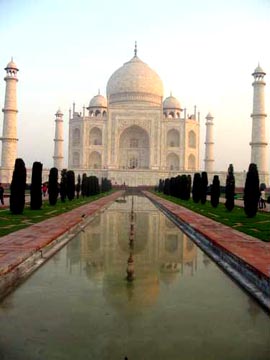 An architectural write-up on the Taj cannot be complete without a word on the issues affecting it today. The first, of course, and the most prominent, is the furor over acid pollutants from industries in and around Agra severely affecting the marble of the tomb. A Supreme Court directive ordered that these industries should clean up their act. This apparently sound decision has raised the hackles of some conservationists and social activists, who argue that a blanket ban on polluting industries is simplistic and does not take into account the complex socio-economic structure of the city. Banning industry per se will lead to loss of jobs and so another, more sensitive solution should be found.
An architectural write-up on the Taj cannot be complete without a word on the issues affecting it today. The first, of course, and the most prominent, is the furor over acid pollutants from industries in and around Agra severely affecting the marble of the tomb. A Supreme Court directive ordered that these industries should clean up their act. This apparently sound decision has raised the hackles of some conservationists and social activists, who argue that a blanket ban on polluting industries is simplistic and does not take into account the complex socio-economic structure of the city. Banning industry per se will lead to loss of jobs and so another, more sensitive solution should be found.
Another issue is that of cultural significance. Cultural significance is defined as the unique blend of social, historical and ethnological factors that give a place its particular character and appeal. In the case of Agra, its cultural significance is that of an ancient Indian city which has been the seat of power of the Mughals for many years, thus leaving behind a distinct culture and architecture.
The Taj is not the only thing in Agra of significance, yet its preponderance and a massive influx of tourists means that traditional professions and craft skills in the city are in danger, with a larger and larger percentage of the population turning to the tourism industry to make a livelihood. This fact is changing Agra so that it is in danger of losing its unique cultural specificity. The recent Taj Heritage Corridor proposal was struck down precisely because it did not adequately investigate future ramifications.
Tourism thus can be a danger if not sensitively incorporated into existing local culture, and can in extreme cases change the very nature of the object of attraction – in this case the city of Agra and the Taj.
I would like to thank Harneet Bhatia, Architect, for letting me use his excellent pictures of the Taj.
*. Tadgell, C. The History of Architecture in India, Viking, New Delhi, 1990.
11-Apr-2004
More by : Ashish Nangia

|
i am not satisfied by this images............! |